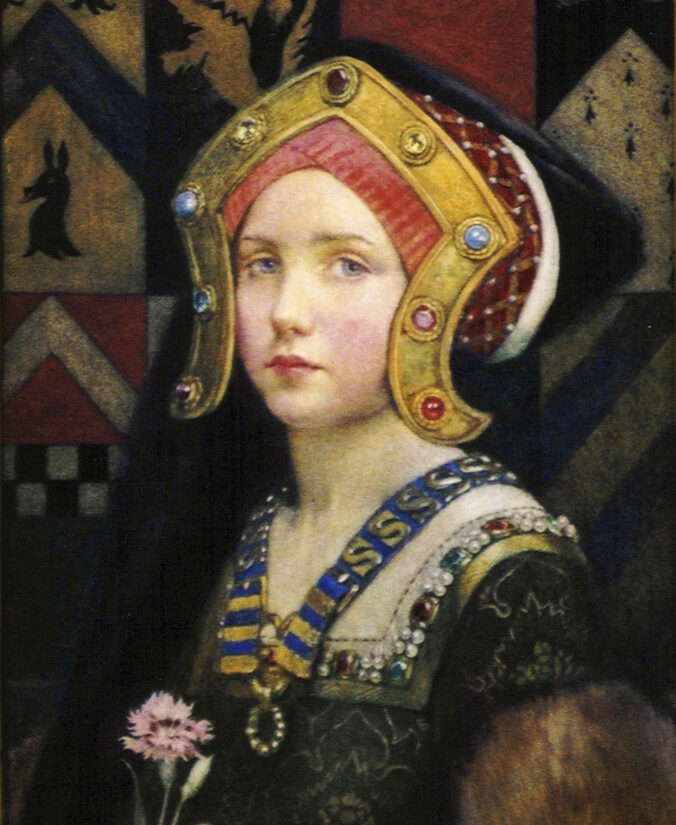 Eleanor Fortescue-Brickdale, Public domain, via Wikimedia Commons
Eleanor Fortescue-Brickdale, Public domain, via Wikimedia CommonsThe Tudor period, spanning the late 15th to early 17th centuries, was full of intrigue, brutal power plays, and a court obsessed with appearances. At a time when everything was political, beauty wasn’t just about attraction—it was about status, morality, and survival. To be considered attractive was to be seen as pure, pious, and powerful. And that came at a painful price.
Tudor beauty standards were extreme. They demanded regular discomfort, exposure to toxic substances, and daily rituals that took their toll on the body. Here’s a deeper look at the beauty ideals of the time and the very real suffering people endured to meet them.
Porcelain skin meant slathering your face in poison.
Pale skin was the ultimate sign of nobility. It implied that you didn’t labour outdoors and were therefore of a higher class. But achieving that flawless pallor wasn’t as simple as staying indoors. Women turned to a substance called Venetian ceruse—a thick white paste made of white lead and vinegar.
Venetian ceruse gave a smooth, chalky finish and covered scars, including those from smallpox. Queen Elizabeth I famously wore it, reportedly applying it so thickly that it cracked like plaster. But it was toxic. The lead seeped into the skin, slowly poisoning the wearer. Symptoms ranged from muscle weakness and gum decay to cognitive decline and, eventually, death. Historical sources confirm the devastating effects of lead poisoning, but in the Tudor era, it was simply the price of looking regal.
Red lips came at a cost.
Once your skin was ghostly white, you needed contrast, and that meant deep red lips. Vermilion was the go-to pigment, made from mercury sulphide. Mixed with fats, oils, or beeswax, it created a bold, seductive red that stood out against pale complexions.
The problem? Mercury is highly toxic. Long-term exposure could lead to skin damage, tremors, mood swings, and even insanity. Still, it remained popular at court, where women were expected to look lively and alluring, even if their health was failing. Some safer alternatives, like beetroot juice or cochineal (made from crushed insects), were used too—but they lacked the staying power and vibrancy of mercury-based pigments.
High foreheads meant tearing your hair out—literally.
A high, rounded forehead was considered a mark of intelligence and noble breeding. So women shaved or plucked the front of their hairline to make their foreheads look larger. Some even removed their eyebrows or thinned the hair at the temples to enhance the effect.
This process wasn’t just uncomfortable—it was relentless. The hair had to be kept at bay constantly, often using sharp blades or tweezers. Infections were common, especially when combined with heavy cosmetics. Some women reportedly used poultices or herbal mixtures to slow hair regrowth, many of which contained irritating ingredients like arsenic or lye.
Hair dye was risky, painful, and completely unpredictable.
Blondes were admired in Tudor England, as golden hair was associated with youth, beauty, and even virtue. If you weren’t naturally blonde or red-haired, you might try to change that using harsh homemade dyes. One popular recipe involved soaking the hair in alum and rhubarb juice, then sitting in the sun for hours.
Other mixtures used copper, ash, or quicklime. The results varied widely, and the process often left the scalp dry, inflamed, or chemically burned. In some cases, the hair would fall out altogether. But the desire to match courtly ideals outweighed the damage it caused, and many persisted despite the obvious risks.
Corsets and bodices squashed internal organs.
The famous corsets of the Victorian period hadn’t quite arrived, but the Tudor version—stiffened bodices and tightly laced kirtles—were hardly forgiving. Women were expected to maintain a conical figure: broad shoulders, flat torso, and a nipped-in waist. Achieving this required compression, stiff busks, and rigid understructures.
Wearing these garments every day meant restricted breathing, reduced digestion, and muscle weakness. It also limited movement, reinforcing the idea that a noblewoman should be still and passive. Farthingales, the wide hoop skirts worn underneath gowns, added extra bulk and weight, making sitting or walking difficult. Comfort didn’t factor into fashion—it was about discipline and control.
Beauty patches masked illness, and invited more problems.
With heavy cosmetics came side effects—rashes, pockmarks, and sores. To cover them, women used beauty patches: small bits of black silk or velvet cut into stars, moons, or circles and glued onto the skin. These patches became trendy accessories, seen as flirty or mysterious.
But they didn’t solve the underlying issues. The adhesives often contained animal glue or plant resins that caused irritation or allergic reactions. In some cases, the patches hid open wounds, trapping bacteria underneath. Rather than fixing the damage caused by lead-based paint or mercury pigments, they often made things worse.
Fragrance came from questionable—and cruel—sources.
Tudor hygiene was limited. Regular bathing was rare, so people relied on perfumes and scented sachets to mask body odour. Scents were made from rose water, spices, herbs—and animal-derived substances like musk, civet, and ambergris.
Civet, in particular, came from the glands of civet cats, and was harvested through painful extraction methods. Ambergris, a waxy substance found in the intestines of sperm whales, was highly prized. While these scents were considered luxurious, they were controversial even in their own time, and today they’re recognised as unethical and environmentally harmful. Still, for Tudor elites, wearing exotic perfume was a sign of wealth and sophistication.
Rouged cheeks could poison you slowly.
Blush—or ‘rouge’—was another staple of the Tudor beauty regime. Bright cheeks suggested health and vitality, which was important in an era when actual health was hard to come by. To achieve the look, women applied mixtures containing cinnabar (another form of mercury), red lead, or carmine.
These pigments were ground into powder and mixed with animal fat or plant oils. They stayed on the skin but absorbed into it too. Over time, they caused ulcers, fatigue, and neurological symptoms. Still, to appear rosy and radiant was worth the risk.
Teeth were blackened or replaced with dubious materials.
Dental hygiene wasn’t great in Tudor England, and sugar had only recently become more available to the wealthy. As a result, rotten teeth became common—ironically, a sign of status. Some people painted their teeth black to mask decay or make it look intentional.
Others filled gaps with animal bone, ivory, or metal. These makeshift dentures rarely fit well and often caused more infections. Queen Elizabeth I was rumoured to have had poor teeth and covered her mouth with her hand when speaking or laughing. Still, an acceptable smile—however it was achieved—mattered at court.
Tudor beauty standards demanded discipline, resilience, and often a willingness to risk your health. The perfect look involved scraping skin, ingesting poison, and enduring days in stiff, restrictive clothing. But for those trying to survive court life—or catch the eye of someone powerful—it was non-negotiable. Behind the elegance and painted faces was a daily routine of discomfort that many were forced to accept as the cost of ambition and belonging.



